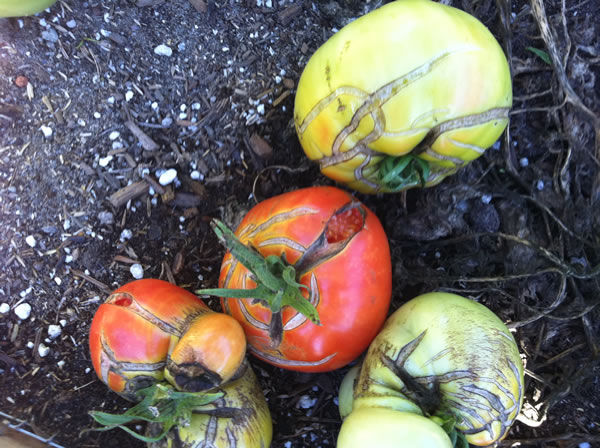It is very common for tomatoes to split, and there are a couple of reasons for these unsightly cracks. Split tomatoes can be caused by either moisture or heat stress.
You may find tomatoes with large cracks that form concentric circles around the stem. This splitting is caused by moisture stress, when the fruit becomes too plump too quickly and literally bursts through the skin. This typically occurs after a heavy rainfall that follows a dry spell.
Large cracks on tomatoes that radiate down from the stem are caused from heat stress. This occurs during periods of bright sunlight and temperatures above ninety degrees.
To help prevent splits from moisture or heat stress, try to maintain even moisture for the plants and provide good drainage in the soil. A thick layer of mulch over the plant’s roots will help keep the soil cool and evenly moist. Remove ripe and nearly ripe fruit after a heavy rain, before it has a chance to split.
Tomatoes that are already ripening can be allowed to finish ripening on the kitchen counter.
The splits are cosmetic only, and won’t affect the flavor of the tomatoes. As long as the fruit is harvested immediately it will still be good for eating.
Don’t let a tomato stay on the plant if it has split as it can easily be invaded by insects or develop mold in the open cracks.

Hi Mike. I ordered your Handbook and find it very useful. Thank you! I was wondering if you have any tips for removing trumpet vine from a chain link fence. Thick branches grew into the fence. We have tried cutting them out but some are thick and have grown right into the wire.of the fence. Any tips or ideas would be appreciated..
Also i just want to say a quick thank you for your highly informative emails.
Melanie,
About all I can suggest is killing the vines and removing what you can. Might not be possible if they are embedded in the fence.
Thanks Mike!
Thank Mike for sharing so much great information on all things garden.
I can’t do what I used to, but still enjoy gardening, just on a much smaller scale. One of your gardeners was asking why tomatoes split
For what it is worth: my grand Uncle and grandfather would never plant a tomato into the ground without digging the hole just a hair deeper, then adding 1 teaspoon of Sulphur Powder, cover the Powder and set your tomato plant.
In my 70+ years of gardening and all types of soil, I can perhaps count on one hand the number of split tomatoes we ever had. Don’t know if it was fact or fiction but it sure works for me.
Thanks for the tip Loraine.
As a gardener, I appreciate your website and the information and guidance you provide. Thank you!
For the past several years I’ve enjoyed Mike’s advice, emails and suggestions. I wish I could afford to join the Backyard Growers’ Club. Maybe if I had a membership, I could afford to pay for it…?
YES, PLEASE, throw my name into the ring!
I love visiting your site with your wholesome easy going and informative advice. In this world full of stress, it is so refreshing to find someone who makes a living and still has good old fashioned values. GOD bless you and everything you do. Your appreciated.
Thank you Karen, I appreciate that.
It took years before anyone told me “full sun,” didn’t mean all day in Fla.